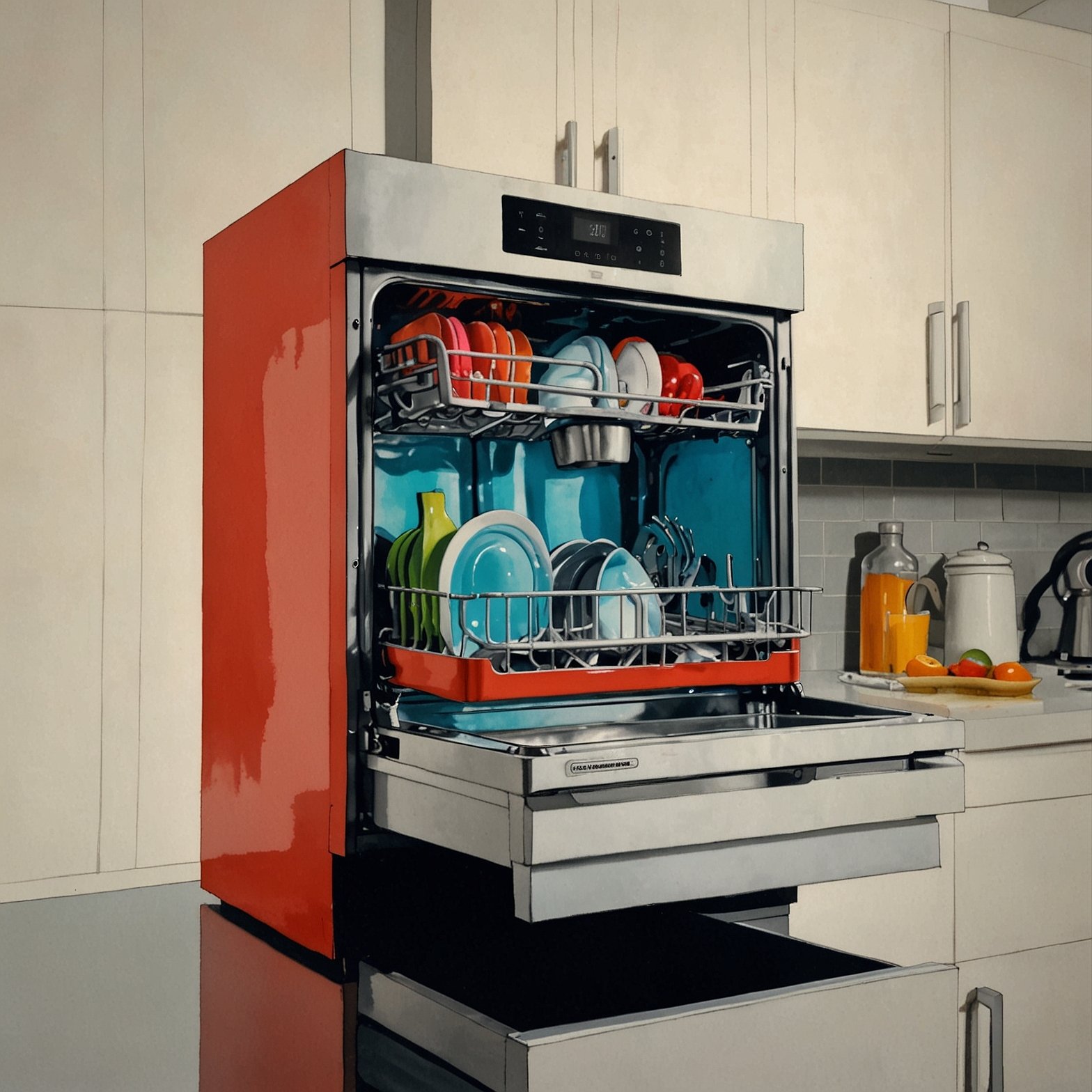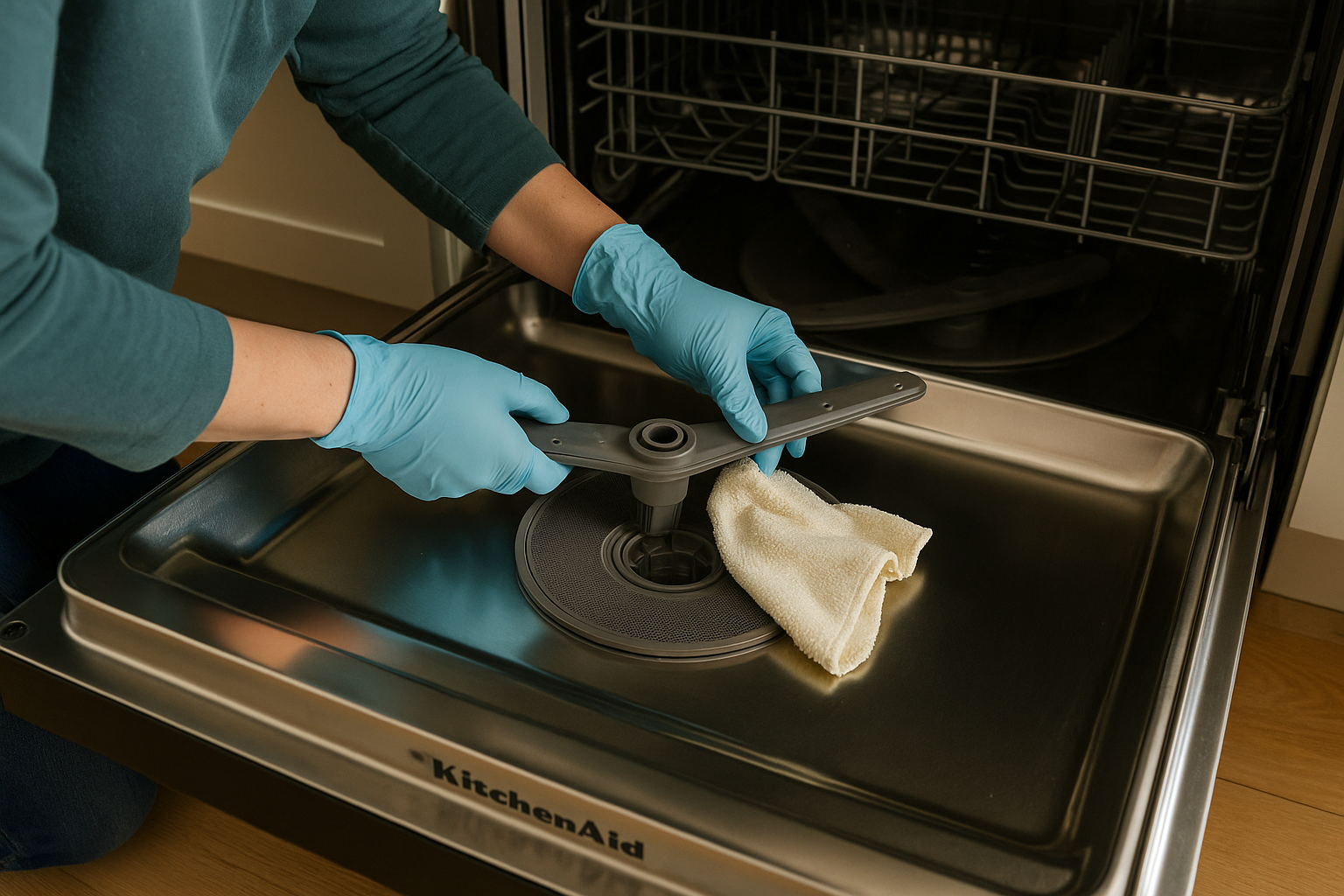To clean your KitchenAid dishwasher, start by removing food debris, then clean the filter and spray arms, run a vinegar cleaning cycle, follow with baking soda or Affresh®, and wipe down seals and the exterior monthly for best performance.
This step-by-step guide ensures optimal dishwasher performance, prevents odours, and extends appliance life.
Why You Need to Clean a KitchenAid Dishwasher

Cleaning your KitchenAid dishwasher often helps prevent food buildup. It also reduces odors and boosts cleaning power. Clogged filters and mineral deposits can hurt performance. Without maintenance, they may even cause a breakdown.
- Dishwasher maintenance ensures long-term reliability and prevents costly repairs.
- Odor prevention starts with clean seals, drains, and filters, stopping bacteria and mold.
- Hard water buildup causes white spots and interferes with detergent efficiency.
What You Need to Clean KitchenAid Dishwasher

Before you clean your KitchenAid dishwasher, gather some tools and safe cleaners.
- Use a soft cloth or sponge, plus a toothbrush or toothpick, to clean small crevices and edges effectively.
- Have white vinegar and baking soda ready to perform a natural deep clean and neutralize odors.
- Use Affresh® Dishwasher Cleaner as an alternative deep-cleaning option designed for KitchenAid models.
7 Steps to Clean Your KitchenAid Dishwasher
1. Remove Food and Debris
Cleaning the bottom of your dishwasher helps avoid drain clogs and foul smells.
- Pull out the bottom rack and remove any visible food scraps or debris near the drain filter.
- Wipe the tub interior and edges using a damp cloth soaked in warm soapy water.
2. Clean the Dishwasher Filter
The filter traps food particles, so keeping it clean ensures smooth drainage and odor prevention.
- Turn the upper filter counterclockwise and lift it out; remove the lower filter if applicable.
- Rinse the parts under warm running water and use a toothbrush to scrub buildup and hard water stains.
- Reinstall the filter assembly securely to maintain proper water flow and cleaning performance.
3. Clean Spray Arms
Clogged spray arms reduce pressure and lead to dirty dishes.
- Remove both the upper and lower spray arms by unsnapping or unscrewing them.
- Rinse and back-flush each spray hole to remove stuck food debris or calcium deposits.
- Reattach the arms tightly for even water distribution and high-performance cleaning.
4. Clean the Tub and Door Gasket
Maintaining the tub and door seal prevents the buildup of grease, grime, and mold.
- Wipe down the interior walls, the rubber gasket, and the door edges using warm water and mild detergent.
- Use a toothbrush or soft cloth for tight spaces to remove hidden residue and soap scum.
5. Run a Vinegar Cleaning Cycle
A vinegar rinse helps sanitize the dishwasher and break down grease and limescale.
- Fill a dishwasher-safe bowl with two cups of distilled white vinegar and place it on the bottom rack.
- Run a hot water wash cycle with no detergent to clean the internal components.
6. Follow with Baking Soda or Affresh®
This step removes any lingering smells and mineral deposits.
- Sprinkle one cup of baking soda on the bottom of the dishwasher and run a short, hot cycle.
- Alternatively, place an Affresh® tablet in the detergent tray or bottom tub and run a standard wash.
7. Wipe the Exterior
Don’t forget the outer surfaces to maintain your KitchenAid dishwasher’s appearance.
- Clean the control panel, handle, and door with a damp microfiber cloth and non-abrasive cleaner.
- For stainless steel finishes, use a designated steel polish and always wipe with the grain.
Dishwasher Cleaning Schedule
To maintain your KitchenAid dishwasher, follow a regular cleaning schedule for best results.
- Filter cleaning: Once a month or more often if you use the dishwasher daily.
- Spray arms and tub: Every 2–3 months to prevent buildup and blockage.
- Deep cleaning cycles: Monthly with vinegar or Affresh®.
- Exterior wiping: Weekly or as needed to remove smudges and fingerprints.
Troubleshooting and Pro Tips
Even when you clean your KitchenAid dishwasher, some issues may arise. Here are quick solutions.
- If spray arms stay clogged, use a toothpick or needle to manually remove mineral deposits.
- For a stubborn filter, check for obstructions or consult the user manual for model-specific access.
- Leave the door slightly ajar after cleaning to air out the interior and prevent odour buildup.
Final Summary
Clean your KitchenAid dishwasher every month. This helps it run well, removes bad smells, and makes your dishes cleaner. To keep your dishwasher running well, use vinegar, baking soda, or Affresh® tablets. Clean the filter and spray arms, too. This will help it work like new.
Follow these steps to keep your appliance clean and efficient. It will give you spotless dishes every time.







